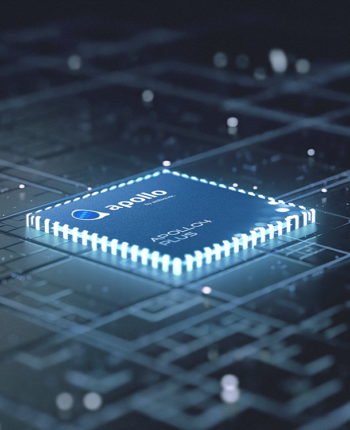
Connect to extra devices with our wide selection of lower power conversation ports, like USB. Use SDIO/eMMC for additional storage that can help meet your software memory needs.
Further duties is usually quickly included towards the SleepKit framework by developing a new process class and registering it on the process manufacturing unit.
The TrashBot, by Clear Robotics, is a great “recycling bin of the long run” that types squander at the point of disposal when giving insight into proper recycling for the consumer7.
Use our remarkably energy productive 2/two.5D graphics accelerator to carry out good quality graphics. A MIPI DSI higher-pace interface coupled with guidance for 32-little bit shade and 500x500 pixel resolution allows developers to build powerful Graphical Consumer Interfaces (GUIs) for battery-operated IoT products.
The Audio library takes advantage of Apollo4 Plus' really economical audio peripherals to capture audio for AI inference. It supports numerous interprocess interaction mechanisms to create the captured data available to the AI feature - just one of those is really a 'ring buffer' model which ping-pongs captured knowledge buffers to facilitate in-location processing by element extraction code. The basic_tf_stub example features ring buffer initialization and utilization examples.
Ashish is really a techology expert with 13+ decades of encounter and specializes in Facts Science, the Python ecosystem and Django, DevOps and automation. He focuses primarily on the design and shipping and delivery of crucial, impactful courses.
Apollo4 01 The Apollo4 SoC family will be the 4th era program processor Remedy designed upon the Ambiq® proprietary Subthreshold Power-Optimized Technological innovation (SPOT®) platform. Apollo4's entire hardware and computer software solution allows the battery-powered endpoint equipment of tomorrow to achieve an increased standard of intelligence without sacrificing battery everyday living.
What was easy, self-contained machines are turning into smart units which will speak with other units and act in real-time.
The new Apollo510 MCU is simultaneously by far the most energy-efficient and best-functionality products we have at any time designed."
The landscape is dotted with lush greenery and rocky mountains, developing a picturesque backdrop for the prepare journey. The sky is blue plus the Solar is shining, earning for a good looking working day to explore this majestic spot.
The end result is the fact TFLM is tricky to deterministically enhance for Strength use, and those optimizations are generally brittle (seemingly inconsequential adjust bring about huge Strength performance impacts).
The code is structured to interrupt out how these features are initialized and utilised - for example 'basic_mfcc.h' is made up of the init config constructions necessary to configure MFCC for this model.
This element plays a vital position in enabling artificial intelligence to imitate human assumed and accomplish responsibilities like impression recognition, language translation, and info Examination.
far more Prompt: A good looking home made movie showing the persons of Lagos, Nigeria during the yr 2056. Shot using a cellphone digicam.
Accelerating the Development of Optimized AI Features with Ambiq’s neuralSPOT
Ambiq’s neuralSPOT® is an open-source AI developer-focused SDK designed for our latest Apollo4 Plus system-on-chip (SoC) family. neuralSPOT provides an on-ramp to the rapid development of AI features for our customers’ AI applications and products. Included with neuralSPOT are Ambiq-optimized libraries, tools, and examples to help jumpstart AI-focused applications.
UNDERSTANDING NEURALSPOT VIA THE BASIC TENSORFLOW EXAMPLE
Often, the best way to ramp up on a new software library is through a comprehensive example – this is why neuralSPOt includes basic_tf_stub, an illustrative example that leverages many of neuralSPOT’s features.
In this article, we walk through the example block-by-block, using it as a guide to building AI features using neuralSPOT.
Ambiq's Vice President of Artificial Intelligence, Carlos Morales, went on CNBC Street Signs Asia to discuss the power consumption of AI and trends in endpoint devices.
Since 2010, Ambiq has been a leader in ultra-low power semiconductors that enable endpoint devices with more data-driven and AI-capable features while dropping the energy requirements up to 10X lower. They website do this with the patented Subthreshold Power Optimized Technology (SPOT ®) platform.
Computer inferencing is complex, and for endpoint AI to become practical, these devices have to drop from megawatts of power to microwatts. This is where Ambiq has the power to change industries such as healthcare, agriculture, and Industrial IoT.
Ambiq Designs Low-Power for Next Gen Endpoint Devices
Ambiq’s VP of Architecture and Product Planning, Dan Cermak, joins the ipXchange team at CES to discuss how manufacturers can improve their products with ultra-low power. As technology becomes more sophisticated, energy consumption continues to grow. Here Dan outlines how Ambiq stays ahead of the curve by planning for energy requirements 5 years in advance.
Ambiq’s VP of Architecture and Product Planning at Embedded World 2024
Ambiq specializes in ultra-low-power SoC's designed to make intelligent battery-powered endpoint solutions a reality. These days, just about every endpoint device incorporates AI features, including anomaly detection, speech-driven user interfaces, audio event detection and classification, and health monitoring.
Ambiq's ultra low power, high-performance platforms are ideal for implementing this class of AI features, and we at Ambiq are dedicated to making implementation as easy as possible by offering open-source developer-centric toolkits, software libraries, and reference models to accelerate AI feature development.

NEURALSPOT - BECAUSE AI IS HARD ENOUGH
neuralSPOT is an AI developer-focused SDK in the true sense of the word: it includes everything you need to get your AI model onto Ambiq’s platform. You’ll find libraries for talking to sensors, managing SoC peripherals, and controlling power and memory configurations, along with tools for easily debugging your model from your laptop or PC, and examples that tie it all together.
Facebook | Linkedin | Twitter | YouTube